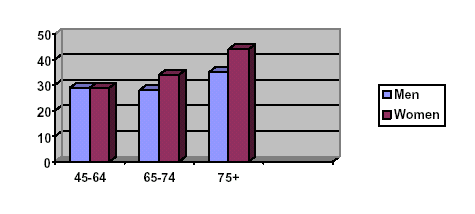|
Millions of
Americans, most of them older adults, suffer from chronic illnesses that can be
prevented or improved through regular physical activity. In a 1993 study, 14
percent of all deaths in the United States were attributed to insufficient
activity and inadequate nutrition.
Lack of physical activity is an important contributor to many of the most
important chronic diseases for older Americans, including heart disease,
diabetes, colon cancer, and high blood pressure. Lack of physical activity,
along with poor nutrition, is a major contributor to the growing epidemic of
obesity in the United States.
Prevalence of Inactivity in Older Adults
Few older adults achieve the minimum recommended
30 or more minutes of moderate physical activity on 5 or more days per week.
Data from the Centers for Disease Control and Prevention (CDC) indicate that
about 28 percent to 34 percent of adults aged 65 to 74 and 35 percent to 44
percent of adults ages 75 or older are inactive, meaning they engage in no
leisure-time physical activity. Inactivity is more common in older people than
in middle-aged men and women. Women were more likely than men to report no
leisure-time activity.
Figure 1. Physical Inactivity for U.S.
Men and Women, 2000 (Percent Inactive)

Source:
Behavioral Risk Factor Surveillance Survey. Centers for Disease Control and
Prevention, National Center for Chronic Disease Prevention and Health Promotion.
National data indicate that few older persons
engage in regular physical activity. Only 31 percent of individuals aged 65 to
74 report participating in 20 minutes of moderate physical activity 3 or more
days per week, and even fewer (16 percent) report 30 minutes of moderate
activity 5 or more days per week. For those aged 75 and older, levels of
activity are even lower: 23 percent engage in moderate activity for 20 minutes 3
or more days per week and only 12 percent participate in such activity for 30
minutes 5 or more days per week.
Thus, many older Americans are inactive and even
more do not get enough physical activity to provide important health benefits.
There has been no improvement in the levels of physical activity among older
adults over the past decade in the United States.
Vigorous physical activity—activity that causes
heavy sweating or large increases in heart rate—is better than moderate activity
for maintaining cardiorespiratory fitness, but relatively few older persons
engage in regular vigorous activity (i.e., three times per week or more), and
the numbers decline steadily with age. Estimates for 2000 indicate that, only 13
percent of individuals between ages 65 and 74 reported engaging in vigorous
physical activity for 20 minutes 3 or more days per week, and only 6 percent of
those 75 and older reported such exercise. |